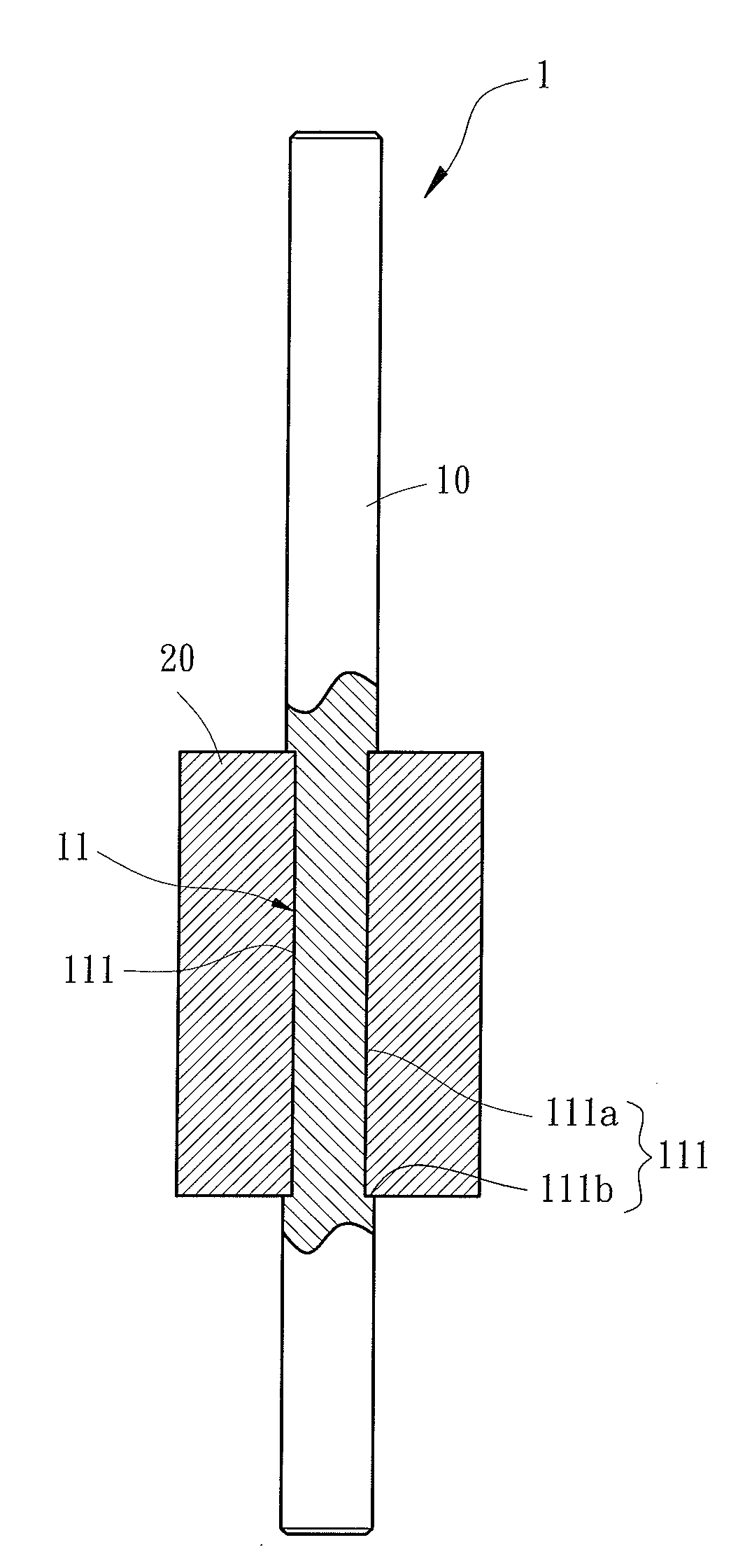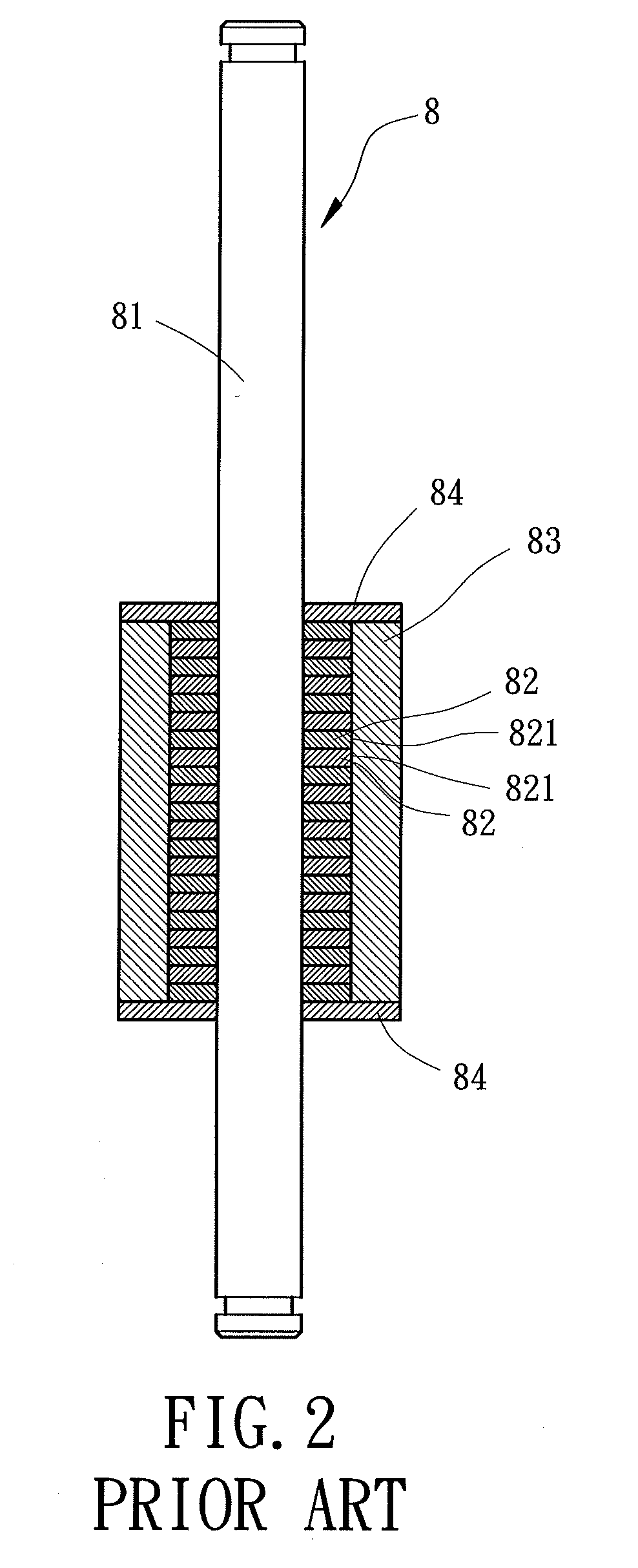Rotor for Motor
a rotor and motor technology, applied in the direction of dynamo-electric machines, magnetic circuit rotating parts, magnetic circuit shapes/forms/construction, etc., can solve the problems of disengagement of magnets, affecting the operation of motors, etc., to achieve the effect of simple structur
- Summary
- Abstract
- Description
- Claims
- Application Information
AI Technical Summary
Benefits of technology
Problems solved by technology
Method used
Image
Examples
first embodiment
[0028]FIGS. 4, 5 and 6 show a rotor 1 for a motor of a first embodiment according to the preferred teachings of the present invention. According to the preferred form shown, the rotor 1 includes a shaft 10 and a plastic magnet 20. The shaft 10 includes a positioning portion 11 on an outer periphery thereof. The positioning portion 11 includes a plurality of grooves 111 each extending in a direction parallel to and spaced from the longitudinal axis of the shaft 10. Furthermore, the grooves 111 are spaced from one another in a circumferential direction. By providing the longitudinally extending grooves 111, the positioning portion 11 has non-circular cross sections perpendicular to the longitudinal axis of the shaft 10. The plastic magnet 20 is formed on the outer periphery of the shaft 10 by injection molding, with the inner periphery of the plastic magnet 20 engaged with the groves 111 of the positioning portion 11. Thus, the plastic magnet 20 is prevented from rotating relative to ...
second embodiment
[0029]FIGS. 7 and 8 show a rotor 2 for a motor of a second embodiment according to the preferred teachings of the present invention. According to the preferred form shown, the rotor 2 includes a shaft 10a and a plastic magnet 20. The shaft 10a includes a positioning portion 12 on an outer periphery thereof. The positioning portion 12 includes a rugged surface 121 on the outer periphery of the shaft 10a. By providing the rugged surface 121, the positioning portion 12 has non-circular cross sections perpendicular to the longitudinal axis of the shaft 10a. The plastic magnet 20 is formed on the outer periphery of the shaft 10a by injection molding, with the inner periphery of the plastic magnet 20 engaged with the rugged surface 121 of the positioning portion 12. Thus, the plastic magnet 20 is prevented from rotating relative to the shaft 10a and from disengaging from the shaft 10a.
third embodiment
[0030]FIGS. 9 and 10 show a rotor 3 for a motor of a third embodiment according to the preferred teachings of the present invention. According to the preferred form shown, the rotor 3 includes a shaft 10b and a plastic magnet 20. The shaft 10b includes a positioning portion 13 on an outer periphery thereof. The positioning portion 13 includes two recesses 131 each including a flat bottom face having a spacing to the longitudinal axis smaller than the outer periphery of the shaft 10b. By providing the recesses 131, the positioning portion 13 has non-circular cross sections perpendicular to the longitudinal axis of the shaft 10b. The plastic magnet 20 is formed on the outer periphery of the shaft 10b by injection molding, with the inner periphery of the plastic magnet 20 engaged with the recesses 131 of the positioning portion 13. Thus, the plastic magnet 20 is prevented from rotating relative to the shaft 10b and from disengaging from the shaft 10b. It can be appreciated that the pos...
PUM
 Login to View More
Login to View More Abstract
Description
Claims
Application Information
 Login to View More
Login to View More - R&D
- Intellectual Property
- Life Sciences
- Materials
- Tech Scout
- Unparalleled Data Quality
- Higher Quality Content
- 60% Fewer Hallucinations
Browse by: Latest US Patents, China's latest patents, Technical Efficacy Thesaurus, Application Domain, Technology Topic, Popular Technical Reports.
© 2025 PatSnap. All rights reserved.Legal|Privacy policy|Modern Slavery Act Transparency Statement|Sitemap|About US| Contact US: help@patsnap.com



